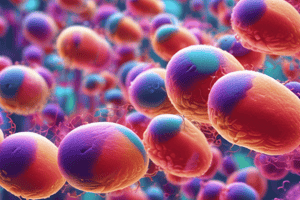Podcast
Questions and Answers
What is the primary focus of molecular diagnostics?
What is the primary focus of molecular diagnostics?
- Detection of nucleic acids and proteins (correct)
- Analysis of environmental factors
- Development of pharmaceuticals
- Study of human behavior
Who is credited with inventing the polymerase chain reaction (PCR)?
Who is credited with inventing the polymerase chain reaction (PCR)?
- Rosalind Franklin
- James Watson
- Kary Mullis (correct)
- Francis Crick
What is the primary application of real-time PCR (qPCR)?
What is the primary application of real-time PCR (qPCR)?
- Quantification of target DNA (correct)
- Sequencing of entire genomes
- Detection of genetic mutations
- Identification of environmental factors
What is the purpose of reverse transcription PCR (RT-PCR)?
What is the purpose of reverse transcription PCR (RT-PCR)?
What is the primary advantage of CRISPR-based diagnostics?
What is the primary advantage of CRISPR-based diagnostics?
What is the primary application of next-generation sequencing (NGS)?
What is the primary application of next-generation sequencing (NGS)?
What is the significance of the discovery of DNA's structure in 1953?
What is the significance of the discovery of DNA's structure in 1953?
What is the common goal of molecular diagnostics techniques?
What is the common goal of molecular diagnostics techniques?
What is the primary target of molecular diagnostics?
What is the primary target of molecular diagnostics?
What revolutionized the field of molecular diagnostics in 1983?
What revolutionized the field of molecular diagnostics in 1983?
What is a key characteristic of next-generation sequencing (NGS)?
What is a key characteristic of next-generation sequencing (NGS)?
What is the purpose of real-time PCR (qPCR)?
What is the purpose of real-time PCR (qPCR)?
What is the function of CRISPR-based diagnostics?
What is the function of CRISPR-based diagnostics?
What is the significance of recombinant DNA technology in molecular diagnostics?
What is the significance of recombinant DNA technology in molecular diagnostics?
What is the primary application of reverse transcription PCR (RT-PCR)?
What is the primary application of reverse transcription PCR (RT-PCR)?
What is a key benefit of molecular diagnostics?
What is a key benefit of molecular diagnostics?
Flashcards are hidden until you start studying
Study Notes
What are Molecular Diagnostics?
- Molecular diagnostics analyze biological markers in the genome and proteome to detect and quantify specific pathogens or genetic conditions.
- These diagnostics focus on the detection of nucleic acids (DNA and RNA) and proteins.
- This field has seen rapid advancements and has become a cornerstone in modern medical diagnostics, offering precise, rapid, and reliable results.
Historical Context and Evolution
- The inception of molecular diagnostics can be traced back to the discovery of DNA's structure in 1953.
- The development of recombinant DNA technology in the 1970s was a significant milestone.
- The polymerase chain reaction (PCR), invented in 1983 by Kary Mullis, revolutionized the field.
- Technological advancements, such as real-time PCR, next-generation sequencing (NGS), and CRISPR-based methods, have expanded the capabilities and applications of molecular diagnostics.
Key Techniques in Molecular Diagnostics
Polymerase Chain Reaction (PCR)
- Conventional PCR: Amplifies specific DNA sequences to detect the presence of pathogens.
- Real-Time PCR (qPCR): Monitors DNA amplification in real-time using fluorescent markers, enabling quantification of the target DNA.
- Reverse Transcription PCR (RT-PCR): Converts RNA into DNA before amplification, essential for detecting RNA viruses.
Next-Generation Sequencing (NGS)
- Allows for the sequencing of entire genomes or specific genetic regions.
- Provides comprehensive data on genetic mutations, pathogen identification, and resistance markers.
CRISPR-Based Diagnostics
- Utilizes the CRISPR-Cas system to identify specific DNA or RNA sequences.
- Offers high sensitivity and rapid results.
- Techniques like SHERLOCK and DETECTR are examples.
DNA Microarrays
- Consist of a large number of probes that can hybridize with complementary DNA sequences from pathogens.
- Allow for simultaneous detection of multiple pathogens.
Biosensors
- Integrate biological molecules with physical transducers to detect the presence of pathogens.
- Offer rapid and on-site diagnostics.
What are Molecular Diagnostics?
- Molecular diagnostics analyze biological markers in the genome and proteome to detect and quantify specific pathogens or genetic conditions.
- These diagnostics focus on the detection of nucleic acids (DNA and RNA) and proteins.
- This field has seen rapid advancements and has become a cornerstone in modern medical diagnostics, offering precise, rapid, and reliable results.
Historical Context and Evolution
- The inception of molecular diagnostics can be traced back to the discovery of DNA's structure in 1953.
- The development of recombinant DNA technology in the 1970s was a significant milestone.
- The polymerase chain reaction (PCR), invented in 1983 by Kary Mullis, revolutionized the field.
- Technological advancements, such as real-time PCR, next-generation sequencing (NGS), and CRISPR-based methods, have expanded the capabilities and applications of molecular diagnostics.
Key Techniques in Molecular Diagnostics
Polymerase Chain Reaction (PCR)
- Conventional PCR: Amplifies specific DNA sequences to detect the presence of pathogens.
- Real-Time PCR (qPCR): Monitors DNA amplification in real-time using fluorescent markers, enabling quantification of the target DNA.
- Reverse Transcription PCR (RT-PCR): Converts RNA into DNA before amplification, essential for detecting RNA viruses.
Next-Generation Sequencing (NGS)
- Allows for the sequencing of entire genomes or specific genetic regions.
- Provides comprehensive data on genetic mutations, pathogen identification, and resistance markers.
CRISPR-Based Diagnostics
- Utilizes the CRISPR-Cas system to identify specific DNA or RNA sequences.
- Offers high sensitivity and rapid results.
- Techniques like SHERLOCK and DETECTR are examples.
DNA Microarrays
- Consist of a large number of probes that can hybridize with complementary DNA sequences from pathogens.
- Allow for simultaneous detection of multiple pathogens.
Biosensors
- Integrate biological molecules with physical transducers to detect the presence of pathogens.
- Offer rapid and on-site diagnostics.
Studying That Suits You
Use AI to generate personalized quizzes and flashcards to suit your learning preferences.




